How has VAR affected the Premier League?
Since its implementation at the start of the 2019/20 season, VAR (Video Assistant Referee) has divided opinion.
After only four years of having the technology in the Premier League, there have been 14 official apologies from PGMOL (Professional Game Match Officials Board) for VAR related mistakes.
It’s undeniable that VAR has changed the experience of watching a Premier League match.
Whether it’s the agonising wait for decisions to be made or the fear of celebrating a goal that is soon to be ruled out, VAR acts more like an additional character in the football melodrama rather than an impartial adjudicator.
Premier League fans protest the use of VAR
As defined by the Premier League: “VAR is used only for ‘clear and obvious errors’ or ‘serious missed incidents’ in four match-changing situations: goals; penalty decisions; direct red-card incidents; and mistaken identity.”
This definition considered, there are three main metrics by which VAR’s impact can be measured: penalties awarded, goals scored and red cards awarded.
Referee Jarred Gillet examines the VAR monitor during West Ham vs Aston Villa
Goals, penalties, and red cards are all game-defining moments, so this article will assess how much of an effect VAR has had in these three areas.
At the time of writing, there have been four complete seasons with VAR (2019/20-2022/23), therefore the data will be compared with the four seasons prior to VAR’s implementation (2015/16-2018/19).
VAR and Goals
As the old cliche goes: “goals change games”, so there is no better place to start than with the most important metric in football.
The graph below shows the average goals per game for each season from 2015/16 – 2022/23. The red bars represent the seasons before VAR, and the blue bars show the seasons after VAR has been implemented.
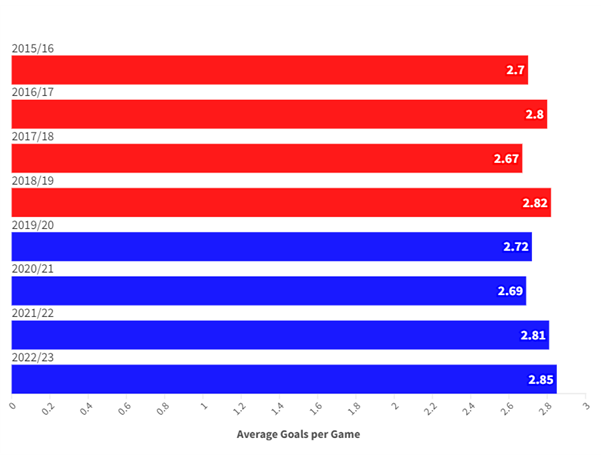
VAR’s effect on football’s most important metric appears to be minimal so far. As indicated by the data above, the average goals per game have stayed at a similar rate since VAR’s introduction. The average goals per game have increased fractionally from 2.75 (pre-VAR) to 2.78 (with VAR).
Further scrutiny is required for the data from the 2019/20 season and the 2020/21 seasons. Both seasons were heavily affected by COVID, with studies showing that scoring rates for home teams in empty stadiums were drastically reduced.
Newcastle face off against Man City in an empty St James Park in 2020
However, the ongoing season (2023/24) currently has an average goals per game of 3.06. This could point to an eventual increase in goals in the Premier League post VAR. At this point though, VAR has had seemingly little effect on how many goals are scored.
VAR and Red Cards
Another fiercely debated facet of VAR is the ability to intervene in “direct red-card incidents.”
In most cases, fans have come to expect that if the referee is recommended to look at the VAR monitor after a bad challenge, the offending player might as well start walking.
In theory, this new ability to retroactively award red cards could potentially lead to more red cards per season. However, the opposite appears to be true:
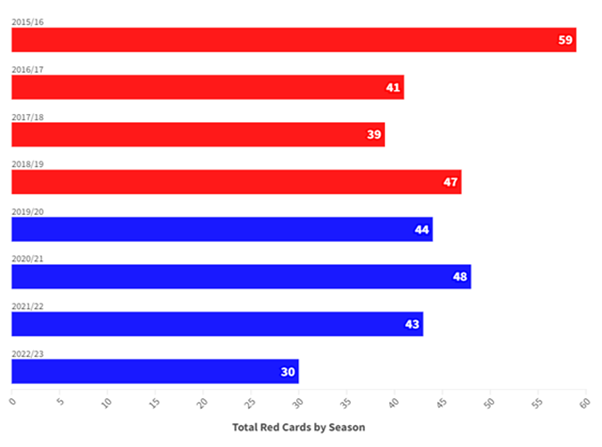
It must be considered that the 2015/16 season has skewed the pre-VAR sample in this example. Pre-VAR seasons had an average of 46.5 red cards.
With VAR, the Premier League currently averages 41.25 red cards per season.
Whilst it may appear that the 2015/16 season was anomalous, the 2011/12 – 2014/15 season average for red cards was 61.5, which shows just how many more red cards were shown before VAR.
In the 2022/23 season, three red cards were rescinded and six red cards were issued after VAR intervention. 17 straight red cards were shown in that season, the lowest in Premier League history.
This trend can be seen across Europe’s ‘Big 5’ leagues as well. On average, the number of red cards has fallen by 5.8% in the Premier League, Ligue 1, Serie A, Bundesliga and La Liga after they implemented VAR.
John McGinn sees red for his challenge on Tottenham’s Destiny Udogie
The 2022/23 season saw referees ‘raising the threshold for fouls and serious foul play’ to adopt a more lenient approach to officiating, which might explain why red cards are now rarer with VAR in place.
Either way, the introduction of VAR has had a significant impact in how many red cards are issued and how they are issued.
VAR and Penalties
The officials’ tendency to award penalties using VAR seems to be the most reviled element of football’s latest technological advancement.
There have been countless examples of referees stopping play and retroactively awarding penalties for incidents that no-one on the pitch, in the stands or at home had seen in the moment.
Paradoxically, VAR’s ability to rescind incorrectly awarded penalties is widely regarded as one of its few inarguable benefits.
It would be fair to assume that VAR would have the same effect on the awarding of penalties as it does with the awarding of red cards.
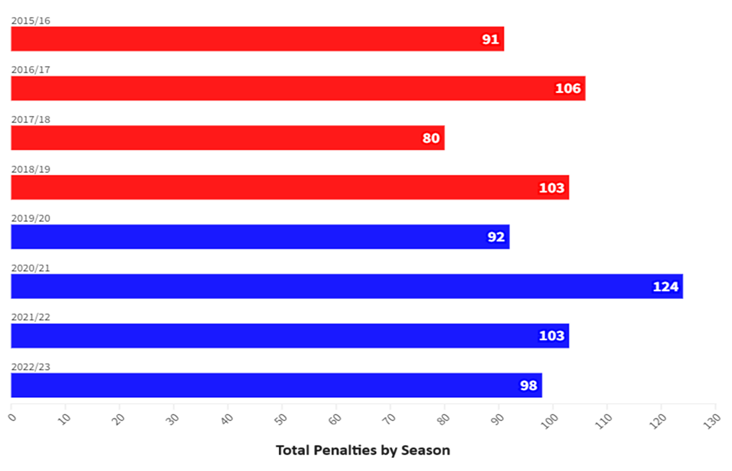
As the graph shows, it turns out that more penalties are given with VAR in place. The pre-VAR season average for penalties awarded was 95, with VAR there is now an average of 104.26 penalties per season.
Below, we can see how VAR has influenced the awarding of penalties since its introduction:
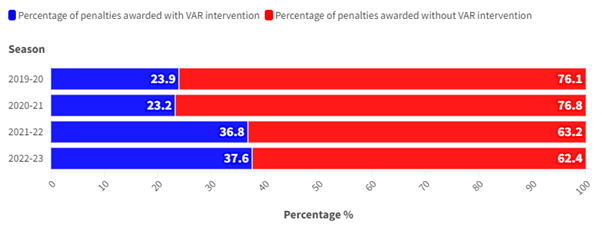
Aside from the 2020/21 season, VAR’s impact on the awarding of penalties has increased every season it has been in place.
This also means an average of 30.4% of penalties awarded from 2019/20 – 2022/23 were done so with VAR intervention, which goes some way to explaining why there are more penalties overall.
VAR and the handball rule have hardly been a match made in heaven.
VAR’s maiden season in the Premier League saw 20 penalties awarded for handball, with 35% of them coming via VAR intervention. The below graph illustrates VAR’s increasing influence in penalty decisions involving a handball:
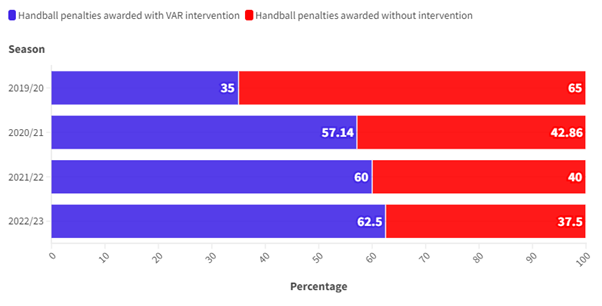
The frequent changing of the handball rule has undoubtedly contributed significantly to the number of penalties awarded via VAR. It’s clear that the introduction of VAR has had a pronounced effect on how penalties are given and how many of them are given.
How has VAR affected the Premier League?
To find out what the referees themselves think of VAR, I sat down with an FA qualified referee, who asked to remain anonymous.
When asked how VAR changes their role, they said: “At the elite level, VAR certainly changes how we referee the game.
“Your calls are scrutinised even more, and sometimes your on-field decision isn’t always final. It can be a blessing and a curse.”
It seems even amongst the referees that use the technology, VAR is divisive.
VAR reviews an incident during Tottenham vs Chelsea
VAR’s implementation has certainly influenced the Premier League and the key metrics that make up a season. The data has shown that considerably more penalties are awarded every season with VAR, whilst less red cards are being shown.
Despite this, the number of goals in an average game hasn’t changed too much. A higher proportion of the goals scored each season will be made up of penalties, given how many more are awarded with VAR.
If the referee is called to the screen regarding a handball in the box, the data shows that it is more likely than ever for them to point to the spot.
If you enjoy the drama of a penalty and hate the game ‘being ruined’ by a red card, then the Premier League has never been better.
